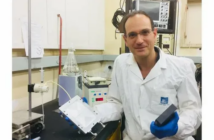POLYMER CONCRETE WITH DISPERSIVE REINFORCEMENT
Figovsky Oleg,
Academician, professor, doctor of technical sciences, Israel Association of Inventors, Haifa.
Israel, figovsky@gmail.com
Shteinbok Arkady( нет фотографии),
PhD, Israel Association of Inventors, Haifa. Israel; Shenkar College, Ramat Gan, Israel,
shteinbok.arkady@gmail.com
Polymer concrete
Polymer concrete is a concrete that uses polybutadiene, a polymer from the liquid rubber
family, as a binder for a conventional aggregate.
Usage of non-metal composite reinforcement in polymer concrete is fair by patent (APP patent
No. 16983646).
The main properties of rubber-polymer concrete in comparison with other concretes.
• Modules of elasticity 2,0-2,7 МPа10 4 , which is about twice as low as regular concrete in
the same circular.
• Will not crack in loads.
• Good adhesion.
• Small water absorption (about 0.05-0.06%)
• High coefficient of chemical resistance (based on 360 days of exposure):
salt water 1.00-1.05 ; about 0.95-0.98 for H 2 SO 4 , Lactic acid, Caustic potash.
• High electric resistance (at least 10 9 Om/cm)
Test results of polymer concrete with dispersive reinforcement by polypropilen (2021)
For testing used samples-prisms of size: 40 × 40 × 160 mm
with dispersed reinforcement by polypropylene (12/0.12 mm).
At the next graph shown the depending of compressive strength on the percentage of
dispersed reinforcement
Laboratory results for dynamic loads of polymer concrete with dispersion reinforcement
A laboratory experiment was conducted at the University of Voronezh Russia. An experiment
was conducted for loads corresponding to the requirements for high-speed railway sleepers
(2 * 10 6 loading cycles). Two types of tests were performed: bending and pressing.
Here are the first results of the experiments:
Dynamic bending:
Strength of sample with steel fibers 40/0.8 mm, relative K. b. ratio, pul = 0.301 and R b, pul = 12.15 МPа
Sample strength with brass fibers 15/0.3 mm , relative K b.pul = 0.413 and R b, pul = 10.91 МPа
Dynamic pressing:
Relative strength, of sample with steel fibers 40/0.8 mm, is R pr, pul = 77.97 МPа
Relative strength, of a sample with brass fibers 15/0.3 mmm is R pr, pul = 75.83 МPа
Relative strength, of a sample with 12/0.12 mm polypropylene fibers, is R pr, pul = 62.91 МPа
When in ordinary concrete strength for axial compression in such loads in the range 15-40 МPа
Electric resistance
It was found, high electric resistance, at least 10 9 Om/cm
Note
1. Polybutadiene electrical resistance is 10 12 — 10 14 Om
2. RubCon is about 10% polybutadiene and 90% sand.
3. Measurement is done by: CHT3542 Precision DC Resistance Meter with Wide
Measurement Range 0.1μΩ~10MΩ
Conclusions based on testing results (2021-2022)
• Experiments were carried out and the relative limits of endurance in compression were
determined on the basis of 2*10 6 cycles.
• Endurance limit for fibrocauton with dispersed reinforcement with polypropylene fiber
12/0.12 mm Rpr,pul= 62.91 MPa.
• Polymer concrete with dispersive reinforcement by polypropylene is resistant to
dynamic loads and suitable for use in dynamic loads.
• Because of its ability to insulate electricity (at least 109 Om/cm), it can also be used as
strong and stable insulating components
Possible and existing uses
• Polymer concrete is more flexible, therefore also more stable to dynamic loads. It allows
the use of in buildings with dynamic loads. Such as polymer concrete sleepers (high
dynamic loads and vibration).
• new construction or repairing of old concrete, nuclear industry, burial of nuclear
sawdust, electrical construction.
• High chemical resistance makes it suitable for uses in sewage systems and structures in
seawater (sewage pipes, communication channels etc.), coating floors and roads.
Иллюстрация: What is Polymer Modified Concrete? || Polymer Cement Concrete || Types of Concrete #9.2 — YouTube
youtube.com











